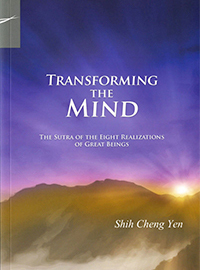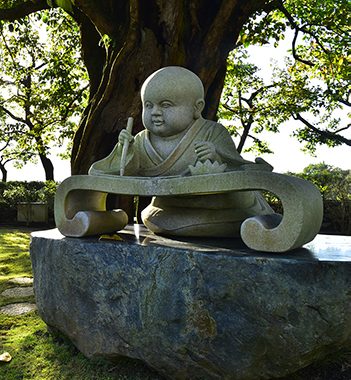Containing only 381 Chinese characters in total, the Sutra of the Eight Realizations of Great Beings is succinct, to the point, and easy to study. Although this sutra lacks the features which most commonly characterize other Buddhist sutras, it is highly esteemed in Chinese Buddhism. The Eight Realizations of Great Beings are the eight methods for bodhisattvas to become enlightened and attain buddhahood. “Great Beings” refers to bodhisattvas, those who are fully replete with Buddha-nature. This is because they have fully cultivated precepts, Samadhi, wisdom, liberation, and liberation’s understanding and views; they have attained the fruits of the practice; and they will never retreat from their spiritual aspirations. Thus, they are Dharmakaya bodhisattvas who form great aspirations and great vows and walk the great path.
Master Cheng Yen first gave teachings on this sutra in 1984, speaking mainly to an audience of Tzu Chi commissioners. Later, in 2002, after a series of disasters that transpired between 1999 and 2002, Master Cheng Yen urged everyone to understand that such disasters arise due to the collective karma of sentient beings, and that everyone should prepare for crises during times of peace. She also encouraged everyone not only to realize the impermanence of this world, but also how to adjust their mindsets, and even how to influence others so that everyone can work together to bring peace to society. This publication is a compilation of teachings given on this sutra between 1984 and 2002.
Including the title, the Sutra of the Eight Realizations of Great Beings contains 381 Chinese characters. The sutra is succinct, to the point, and easy to study and practice.
This sutra differs from other Buddhist sutras, which usually begin with the phrase, “Thus have I heard.” Moreover, other sutras will usually end with the phrase, “The assembly faithfully accepted and practiced the teachings.” This sutra lacks all of these features. Although the sutra might be a compilation of teachings rather than expounded by the Buddha in a single Dharma assembly, it is highly esteemed in Chinese Buddhism.
The Sutra of the Eight Realizations of Great Beings was translated by An Shigao in the second century AD. In the Sutra of Eight Contemplations, which is found in the Madhyama Agama Sutra, there is a section that includes eight matters that are very similar to the eight realizations found in this sutra. Thus, the eight realizations of great beings are the eight methods for bodhisattvas to become enlightened and attain buddhahood.
“Great Beings” refers to noble beings, meaning great bodhisattvas who are fully replete with Buddha-nature. Bodhisattvas such as these have fully cultivated precepts, Samadhi, wisdom, liberation, and liberation’s understanding and views, attained the fruits, and will never retreat from their spiritual aspirations. They are Dharmakaya bodhisattvas who form great aspirations and vows, and walk the great path. For example, Guanyin Bodhisattva is sometimes also referred to as “the great being in white.”
Once we are awakened, we will no longer be deluded. By realizing that life is suffering, bodhisattvas become awakened beings who practice with the spirit of great wisdom, great practice, great compassion, and great vows in this world. As Buddhist practitioners, this is what we should seek to emulate!
During the new year of 1983, before the construction work began for Hualien Tzu Chi Hospital, Master described her three wishes for the new year:
- I seek not for my body to be healthy, but only for wisdom and clarity of mind.
- I seek not for everything to go my way, but only for faith, perseverance, and courage.
- I seek not for less responsibility, but only for more strength.
At that time, she also briefly mentioned the essence of the Sutra of the Eight Realizations of Great Beings to encourage everyone that walking the Bodhisattva Path is the way to truly cultivate blessings and wisdom.
At the Jing Si Abode, Master taught the Sutra of the Eight Realizations of Great Beings a total of three times.
Master first taught the Sutra of the Eight Realizations of Great Beings from September 16, 1984 to September 29, 1985. In every monthly Tzu Chi Commissioners’ Gathering, she taught about the paths to reach enlightenment, so there were twelve teachings in total in that one year. In every meeting, Master always emphasized that to provide relief in the wake of disasters, we must first help save people’s hearts. She reminded everyone that blessings and transgressions are all created by the mind, and that of all good deeds, filial piety is the most important. She also explained that we should realize that life is painfully short, and that we should understand the principles of impermanence that apply to all things in this world. Then, we can reflect on our intrinsic nature and awaken our innate sense of morality, thus leaving behind desire, suffering, and disasters.
At that time, the Buddhist teachings were not widespread in Taiwan, and the audience consisted of Tzu Chi commissioners and donating members. When explaining the sutra, Master was considerate and used language suitable for the audience of that time. She used simple examples relating to the state of this world to explain profound Buddhist principles. This helped the Tzu Chi commissioners clearly understand them and gave commissioners the ability to share them with their donating members.
During that time, Master Cheng Yen was busy raising funds for the construction of Hualien Tzu Chi Hospital. Before she gave her Dharma teachings, she would first report on the latest updates on the construction. She would also share touching stories to encourage everyone to form bodhisattva aspirations and make Earth Treasury Bodhisattva’s vows to advance diligently in Tzu Chi’s mission of helping people. She also elaborated on Tzu Chi’s goal of working “for Buddha’s teachings, for sentient beings,” which is also the spirit of walking the Bodhisattva Path as described in the Lotus Sutra. She reminded everyone to gradually advance, step by step, to establish the Jing Si family tradition and the rules of the Tzu Chi School of Buddhism.
By the time she concluded these teachings, it was the Mid-Autumn Festival. Master gave her encouragement and blessings to everyone, wishing for everyone’s wisdom-life to be forever bright like the sun and the moon!
This teaching was first published by Tzu Chi Cultural Pub. Co. in May 1999 in The book, The Sutra of the Bodhisattvas’ Eight Realizations.
The second time Master Cheng Yen taught the Sutra of the Eight Realizations of Great Beings was from November 2002 to January 1, 2003. At that time, Master was concerned about how the world is currently in the era of Dharma-degeneration, and that sentient beings’ severe defilements create afflictions which lead to turmoil in people’s minds and communities, as well as cause many disasters around the world. Furthermore, people are constantly destroying the earth. As a result, during her Dharma talk each morning, Master taught this sutra over thirty-two sessions to the lay and monastic practitioners at the Abode, along with the hospital volunteers.
In 2002, Tzu Chi’s four missions of charity, medicine, education, and humanistic culture had all begun their development. However, around the world, disasters continued to spread every day due to an imbalance in nature’s four elements.
The affinities of bodhisattvas are with suffering sentient beings. Tzu Chi volunteers overseas emulated the foundation’s charity work in Taiwan and actively recruited Living Bodhisattvas. They gradually grew stronger and established new chapters to put the Six Paramitas of giving, precepts, patience, diligence, Samadhi, and wisdom into action.
This time, as Master taught the Sutra of the Eight Realizations of Great Beings, several significant events had taken place around the world. These included the Angke River flooding in Indonesia, wildfires in California, the August 17, 1999 earthquake in Turkey, the September 21, 1999 and March 31, 2002 earthquakes in Taiwan, flooding in Austria and the Czech Republic, the war in Kosovo, and others.
Master reminded everyone that we should clearly understand the disasters in this physical world, and she instructed everyone to prepare for crises in times of peace. By studying the Sutra of the Eight Realizations of Great Beings, not only do we realize the impermanence of this world, we also learn how to adjust our mindset, and even how to influence others so that everyone can be in harmony, thereby bringing peace to society. If people’s minds are at peace, the world will be at peace.
This round of teachings was first published by Tzu Chi Cultural Pub. Co. in April 2004. The name of the book was Transforming the Mind: Sutra of the Eight Realizations of Great Beings.
Master taught the Sutra of the Eight Realizations of Great Beings for the third time in March 2010. At that time, she felt that time was running out for the world. For eight consecutive days, Master taught this sutra to the lay and monastic practitioners at the Abode and to volunteers during the morning volunteer assembly. As time was limited and the content was also short, these teachings were not compiled into a book.
This compilation is based on the teachings from 1984 and 2002. We incorporated the newer teachings with the old, connecting the principles with examples to clarify their meaning and maintain a clear flow of ideas.
We strive to present, as truthfully and accurately as possible, Master’s complete explanations of the sutra text as they relate to the times and the state of the world at the time. In her explanations, Master closely followed international issues and social changes, and she constantly proposed prescriptions in response to the ailments of this world with the intention to help comfort people’s hearts and encourage them to take practical actions to compassionately help the world and exercise the kindness, beauty, and altruistic potential of humanity. Her urgency and sentiment to help people both physically and spiritually allows readers to picture the situation and feel as if they were there in person.
Although nearly twenty years have passed, these principles and matters are still relevant. Furthermore, this work testifies to how, from the start, Master has consistently upheld her compassionate vow to promote the concept of “integrating the Buddha Dharma in daily life and becoming Living Bodhisattvas in this world.”
In particular, she repeatedly called out to present and future generations. Her every reminder and loving word brings us deeply into the Buddha Dharma while clearly illustrating the state of the world. She is truly giving a testimony to the times, writing the history of this world, and establishing a sutra treasury for Tzu Chi.
The editorial team abides by the principles of faithfulness, comprehension, and elegance. We follow Master Cheng Yen’s sequence of ideas and her tone of teaching so as to be faithful to her teachings and to the context. We have preserved the meanings, principles, and the flow of the words so that they are clear and easy to understand, and we have focused on the elegance of the writing so that the reader may find the teachings readable and enjoyable.
The writing on the cover is based on Master Cheng Yen’s calligraphy when she first transcribed the Sutra of Infinite Meanings and the Wondrous Lotus Sutra by hand. The inclusion of the words “teachings and commentary” in the book title represents how, while Master expounds the sutra, she makes use of events from the past to the present, across the long river of time. This affirms that “all buddhas share the same path”; the teachings are just as relevant to modern living as they were when Sakyamuni Buddha originally taught them. The word choice is modern, while also retaining the usages of many ancient words. Parts of the teachings also contain original terms created by Master Cheng Yen, which differ from more common expressions, yet can explain the sutra’s key meanings even more thoroughly.
The original Chinese publication of this book was made possible by the Jing Si Abode’s monastic practitioners, Pure Practitioners, Tzu Chi volunteers, and others. A total of more than 200 participants helped to transcribe, proofread, and compile the content from the original audio recordings.
After editing, in pursuit of the utmost circumspection and reverence for the teachings, we requested volunteers and masters at the Jing Si Abode to read the transcription, and to give feedback on the matters and principles contained within, as well as any doubts they may have had as they read it. We finalized the draft only after repeated discussions and amendments.
For the Chinese version, designer Chen Jun-Liang’s team from Freeimage Design helped with the cover and proposed a text layout where each verse can inspire silent contemplation and each paragraph can stand on its own, while together they form an entire chapter. This design allows the Buddhist sutra to suit modern Chinese reading habits and to be more deeply integrated into our contemplation of daily living. [1]
We share Master’s closing words in this book with everyone as encouragement – “The text in the Sutra of the Eight Realizations of Great Beings is very short. Yet, our journey of spiritual practice, from the beginning in suffering, to the methods used in the practice, through to our final liberation, are all inseparable from the eight matters mentioned in the sutra. If we can all recite it, make good use of it, and exercise wisdom to transform sentient beings, naturally, we can cultivate both blessings and wisdom. Thus, our wisdom will be like the sun, and our compassion will be like the moon, forever radiant and bright. We can further lead all sentient beings to awaken to the suffering of life and death.”
Department of Dharma and History Compilation
Jing Si Abode, February 2016





